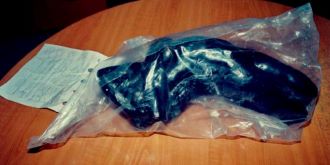
Stealing Rodin 2017
Distributed by Pragda, 302 Bedford Ave., #136, Brooklyn, NY 11249
Produced by Maria Paz Gonzalez
Directed by Cristobal Valenzuela Berrios
Streaming, 80 mins
College - General Adult
Art; Crime; Museums
Date Entered: 04/12/2022
Reviewed by Brian Falato, University of South Florida Tampa Campus LibraryThe opening of an exhibit in Santiago, Chile of works by French sculptor Auguste Rodin was a happy time for the arts community in the South American country. It was the first time a Rodin exhibit had ever been held there. But joy turned to sadness, embarrassment, and puzzlement the day after the exhibit opening. One of the Rodin works, a small bronze sculpture titled "Torso of Adele," was discovered missing. Who took it and the reasons why are the focus of Stealing Rodin.
The video features interviews with museum personnel, art historians, and the thief himself, all done in Spanish with English subtitles. It uses re-enactments to visualize events described, and also contains silent black-and-white footage of Rodin.
Investigators had no clues about the theft because the security camera footage revealed nothing. There was no lightning in the area when the theft took place, and the cameras did not have infrared capabilities, meaning all the footage was black. An international art theft ring was suspected, and an artist with an exhibit in the museum at the same time fell under suspicion.
The real culprit soon was revealed, though. Luis Emilio Onfrey Fabres came forward with the sculpture, saying originally, he had found it in a bush at a park near the museum. Under questioning from police, he confessed he took the artwork the night of the exhibit opening, during a reception open to the public. He said he went downstairs to use the bathroom, caught sight of the Rodin, and was immediately drawn to it. He picked it up and then put it in his backpack. No alarms went off, and he was able to walk out of the museum.
Onfrey Fabres declares in the video, "I am not a thief. I am an artist." And indeed, he has created a variety of works, including performance art videos. The theft could be seen as a kind of performance art, a document found on his computer revealed.
The document was called "Project: System of Vulnerability." The theft would be an "art action" to "acquire a sculpture during a period of fourteen days and see what happens." It would be a "borrowing" meant as a "social-artistic gesture of raising consciousness," to show "loss brings back to the memory what is missing." The record crowds for the Rodin exhibit who saw only the platform which held the missing statue performed this kind of returning to memory that which wasn't there, according to some of the speakers in the video.
Marcel Duchamp was famous for exhibiting a urinal as an art object. Traditionalists scoff, but a whole conceptual art movement has arisen that focuses not so much on the artistic object, but instead raises questions about "what is art?" and "what is its meaning?"
The actions of Onfrey Fabres can be seen as another example of conceptual art, or as an attempt to justify a crime. Either way, this video will be of interest to classes in art and cultural studies programs and is recommended for academic and larger public library collections.
Awards:It’s All True Film Festival, Best Latin American Documentary; Guadalajara International Film Festival, Special Jury FEISAL Award; Viña del Mar International Film Festival, Best Latin American Documentary; Santiago International Film Festival SANFIC, Special Jury Award; Louisiana Film Festival, New Voices New Visions Award; Toulouse Latin American Cinema Encounters, Special Jury Award
Published and licensed under the Creative Commons Attribution 4.0 license. Anyone can use these reviews, so long as they comply with the terms of the license.